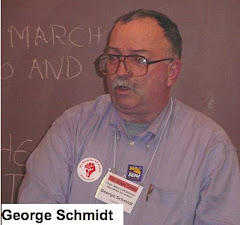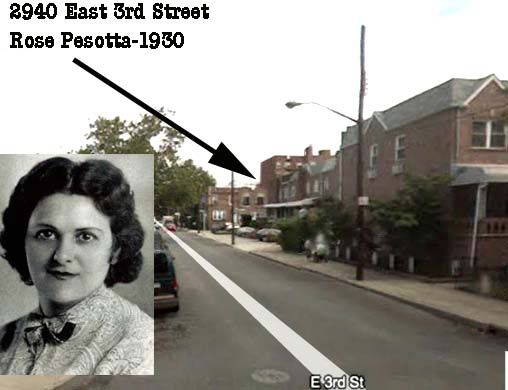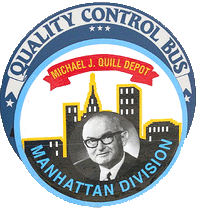more of her biography from the Jewish Women's Encyclopdia
Shortly before her death, Rose Pesotta was asked how she would live her life if she could live it over again. She replied, “I have no regrets of my chosen path of the past. I would choose the same path, trying perhaps to avoid some of the mistakes of the past. But always having the vision before me—in the words of Thomas Paine, ‘The world is my country. To do good is my religion.’” The sweeping idealism of that statement tells us much about Pesotta, anarchist, labor activist, immigrant, internationalist. Known primarily as one of the first female vice presidents of the international ladies garment workers union (ILGWU), Pesotta saw her union organizing as an opportunity to fulfill the anarchist mandate “to be among the people and teach them our ideal in practice.”
Rose Pesotta was born in 1896, the second of eight children, into a middle-class family in Derazhnya, a railroad town in the Russian Ukraine. Her father, Itsaak Peisoty, was a grain merchant, and her mother, Masya, was active in the family business. Pesotta attributed her lifelong concern for social justice to her “dynamic and unconventional” father, but seemed unaware that the shtetl tradition of women’s work outside the home represented by her mother may have also facilitated her career.
Pesotta attended Rosalia Davidovna’s school for girls, with its Russian curriculum and its clandestine classes in Jewish history and Hebrew. After two years at the school, she was needed at home to help care for her siblings, and home tutoring replaced formal schooling. But her political apprenticeship in one of the many leftist groups in the Russian Pale of Settlement was as important as her formal education. She joined her older sister, Esther, in the local anarchist underground. The group’s discussion of well-known leftists Pyotr Kropotkin, Mikhail Bakunin, and Pierre-Joseph Proudhon, and the political activities of young radicals, opened a window on the possibilities of a wider world.
Her parents’ plan to marry her to an ordinary village boy precipitated her decision to join her sister in America. In 1913, her parents gave her permission to embark for the New World. Once in New York, Pesotta began working in various shirtwaist factories, and struggled to learn English. Soon, she joined Local 25 of the ILGWU. The local became a base for her union career. In 1915, she helped the local form the first education department in the ILGWU, and in 1920 she was elected to Local 25’s executive board. In 1922, Pesotta completed the program at the Bryn Mawr Summer School for Workers, and between 1924 and 1926, she was a student at Brookwood Labor College. During the 1920s, she played a key role in the union’s chronic struggles with communists. Grateful union officials recognized Pesotta’s contributions by appointing her as an organizer in the late 1920s.
Pesotta brought a charismatic personality, boundless energy, and a unique ability to empathize with the downtrodden to the organizing field. In 1933, she spearheaded the Dressmakers General Strike in Los Angeles in the face of antipicketing injunctions, hired thugs, and communist dual unions. She mobilized the largely Mexican labor force through Spanish-language radio broadcasts and ads in ethnic newspapers. Although the strike was not successful, Pesotta’s leadership established her as one of the most gifted organizers of the union.
Pesotta’s visibility in California led to her election in 1934 as a vice president of the ILGWU, serving on the general executive board. Pesotta was conflicted about her ten years of service in that position. Sexism and a loss of personal independence continually troubled her, until she finally resigned from the position in 1942.
Between 1934 and 1944, though, Pesotta was one of the most successful organizers in the United States. She carried the union message to workers in Puerto Rico, Detroit, Montreal, Cleveland, Buffalo, Boston, Salt Lake City, and Los Angeles. On loan from the ILGWU to the Congress of Industrial Organizations (CIO), she joined the great labor upheavals of the 1930s in Akron, Ohio, and Flint, Michigan. In 1944, Pesotta refused a fourth term on the CIO General Executive Board, with a brief critical statement that “one woman vice president could not adequately represent the women who now make up 85 percent of the International’s membership of 305,000.”
Following her resignation from union office, Pesotta published two memoirs: Bread upon the Waters (1945) and Days of Our Lives (1958). She worked briefly for the B’nai B’rith Anti-Defamation League and for the American Trade Union Council for the Histadrut, Israel’s labor organization. But she supported herself during those years largely as a factory operative. Her life, in a sense, had come full circle—she embraced what she called “the freedom of a plain rank and file member of the union.”
Anarchism and Judaism are key to understanding Pesotta’s identity and sense of self. Although first introduced to anarchist philosophy in Europe, Pesotta found community and support for her libertarian beliefs in the alternative culture of American anarchism. Anarchism was her ethical center. It celebrated the inherent goodness of the individual and rejected private property, the state, and authority. Like emma goldman and other women attracted to the movement, Pesotta found support for a sexually free life-style embedded in anarchist tenets of personal freedom. She was secretary of the anarchist paper The Road to Freedom and was a key member of the Sacco-Vanzetti Defense Committee.
For Pesotta, anarchism was inextricably enmeshed with Jewish culture and communities. Although not religiously observant, Pesotta always identified herself as Jewish. The Holocaust and the foundation of Israel deepened her sense of herself as a Jew. It seems ironic that her second memoir casts Judaism in a central role after a lifetime spent in secular activism and outside of the family roles critical to Jewish practice. Closer scrutiny reveals the congruence between Pesotta’s idealized past and her American life. In her books, her need to understand “external power relationships” as a Jew in czarist Russia meshed neatly with the Jewish labor union in tension with American culture.
In the fall of 1965, Pesotta was diagnosed with cancer of the spleen. Quietly she resigned from her job and went to Miami to “recuperate in the sun.” On December 4, 1965, she died alone in a Miami hospital.






























